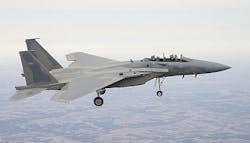Air Force begins testing of advanced F-15 jet fighter with fly-by-wire and digital EW systems
WRIGHT-PATTERSON AFB, Ohio, 31 March 2013. Aircraft and avionics experts from the U.S. Air Force and the Boeing Co. have performed the first test flight of a completely updated version of the F-15 Eagle jet fighter with 21st century avionics and flight-control systems.
The F-15SA, which Boeing is building for the Royal Saudi Air Force, has avionics enhancements that include a fly-by-wire flight control system, digital electronic warfare (EW) suite, an infrared search and track (IRST) system, and active electronically scanned array (AESA) radar.
Experts conducted the flight test under supervision of F-15 designer the Boeing Co. Defense, Space & Security segment in St. Louis, and the Air Force Aeronautical Systems Center at Wright-Patterson Air Force Base, Ohio.
The F-15SA is the centerpiece of the Royal Saudi Air Force F-15 fleet modernization program, a wide-ranging $29.4 billion effort that stands as the largest foreign military sale in U.S. history, Air Force officials say.
The newest and most-advanced version of the venerable F-15 brings improved performance, enhanced situational awareness, and increased survivability at a lower total life-cycle cost, Air Force officials say.
The F-15SA's maiden voyage was on 20 Feb. at the Boeing facilities in St. Louis, and was announced by the Air Force earlier this month.
The F-15SA flight test program will include three instrumented F-15SAs operating from Boeing facilities at St. Louis and Palmdale, Calif. F-15SA new aircraft deliveries to the Kingdom of Saudi Arabia are scheduled from 2015 to 2019.
The Saudi F-15SA is an updated version of the U.S. Air Force Boeing F-15E Strike Eagle fighter-bomber. The F-15SA (Saudi Advanced) variant includes the APG-63(v)3 AESA radar, digital electronic warfare systems (DEWS), infrared search and track (IRST) systems, and other advanced systems.
Saudi Arabia requested 84 F-15SA aircraft, upgrade of its F-15S fleet to F-15SA standard, and related equipment and weapons through a Foreign Military Sale in October 2010.
The F-15 Eagle twin-engine, all-weather tactical jet fighter. The fighter aircraft went on the drawing board originally in 1967, first flew in 1972, and entered service in 1976. The aircraft is considered among the most successful modern fighters, with more than 100 aerial combat victories with no losses in dogfights.
The first versions of the F-15 were air-superiority fighters with secondary ground capability. The F-15E multirole fighter-bomber entered service in 1989. Variants of the F-15 are expected to remain in service with the U.S. Air Force through 2025, although some have been or will be replaced with the F-22 advanced tactical fighter and F-35 joint strike fighter.
For more information contact Boeing Defense, Space & Security online at www.boeing.com/boeing/bds, or the Air Force Aeronautical Systems Center at www.wpafb.af.mil.

